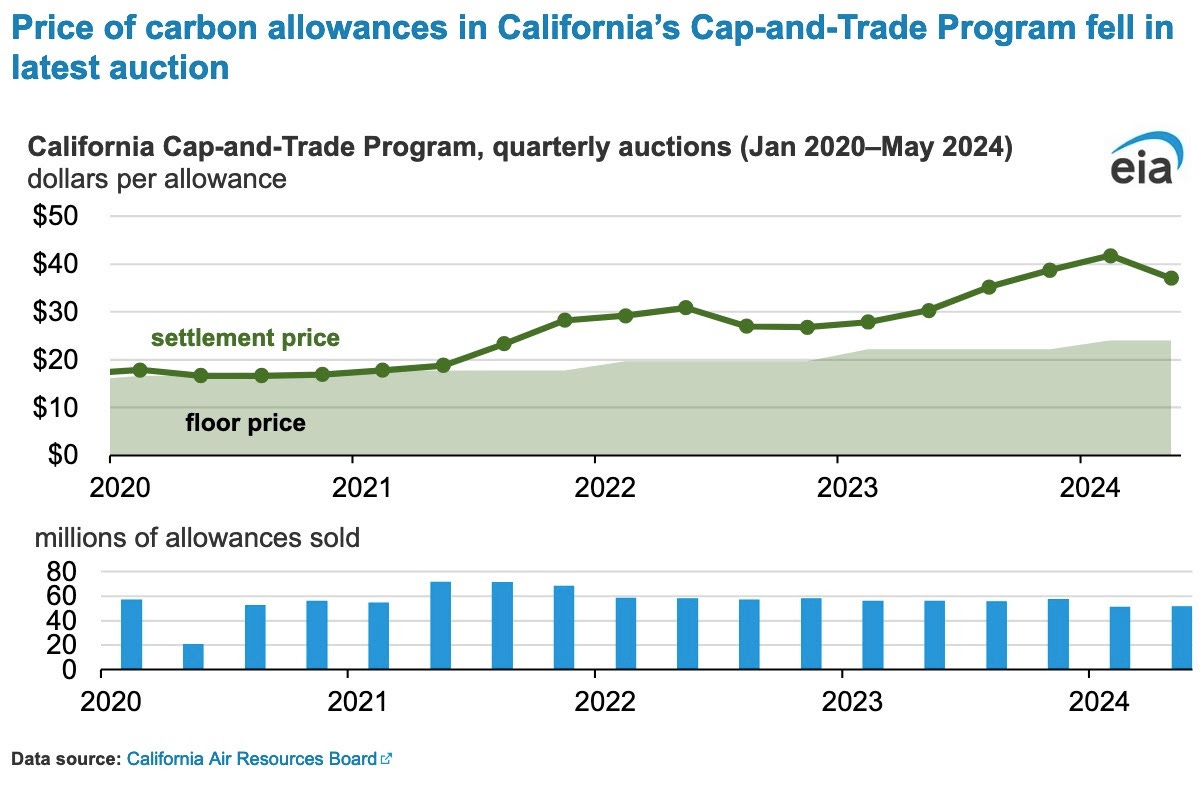California's Cap and Trade Program Experiences Falling Auction Prices and A Failing Energy Program THOMAS J SHEPSTONE
Yesterday, Today In Energy put up one of those dense articles regarding carbon allowances, auctions and greenhouse gas emissions; articles intended to explain the unexplainable
Forwarded this email? Subscribe here for more
California's Cap and Trade Program Experiences Falling Auction Prices and A Failing Energy Program
AUG 1
Yesterday, Today In Energy put up one of those dense articles regarding carbon allowances, auctions and greenhouse gas emissions; articles intended to explain the unexplainable because no one but the special-interest insiders have the slightest grasp as to what’s really happening. Nonetheless, this one on the subject of California’s program tells us a few important things, starting with the fact that system is just another green energy grift at the expense of consumers.
Here is the whole article with some bolding to indicate parts having a bearing on the problems with the program:
Allowance prices for greenhouse gas emissions decreased by 11% in California's quarterly joint carbon auction held in May 2024, breaking the recent upward trend amid uncertainty as to how the state regulator will amend rules governing the auctions.
The auctions are part of the state’s Cap-and-Trade Program, governed by the California Air Resources Board (CARB), the state regulator. CARB requires operators of natural gas-fired and coal-fired power plants, along with other companies, to buy allowances to offset emissions. Each year, fewer allowances are offered at auctions as the annual cap declines. During the latest auction, all the offered 51.6 million allowances sold.
The Cap-and-Trade Program was initially created by California’s Global Warming Solutions Act of 2006 (AB 32), with the aim of reducing greenhouse gas emissions to 1990 levels by 2020, a target that was met in 2016. Lawmakers have since set further reduction targets twice, most recently mandating a reduction in greenhouse gas emissions by 85% below 1990 levels and targeting carbon neutrality by 2045. The program sets a statewide emissions limit on sources responsible for most of California’s greenhouse gas emissions. In 2021, the electric power sector accounted for 10.9% of the state’s emissions.
For each auction, CARB creates allowances equal to the total amount of permissible emissions and sets the cap. CARB also sets a floor on the price for the allowances, which increases each year. Companies are required to hold allowances equal to their greenhouse gas emissions, which can be obtained through allocation, through quarterly auctions, or from other market participants. The increasing annual auction floor price for allowances, along with the reduction in annual allowances, is intended to incentivize investments in less carbon-intense fuels and technologies and more efficient use of energy.
The price of the allowances had been gradually increasing since February 2023. Post-pandemic economic recovery has increased industrial activity and demand for allowances. Market expectations of stricter future regulations and fewer offered allowancescontributed to the upward pressure on prices with respect to carbon costs and to the increasing commitment to emission reductions among market participants.
CARB is in the process of developing amendments to the Cap-and-Trade regulations, which has created uncertainty about the future value of the allowances. California’s goal of reducing greenhouse gas emissions by 2045 requires CARB to issue fewer allowances, but updates have been delayed. Uncertainty also surrounds pending decisions on potential linkage with Washington State’s carbon market.
So, what does this all mean? Well, in the simplest terms, falling prices indicate falling demand for allowances. Why? The answer is found in the last paragraph; potential buyers are waiting to see what CARB comes out with in the way of revised regulations.
CARB, of course, is nothing more than a bunch of bureaucrats (the infamous “experts” so to speak) who get to: (1) arbitrarily decide how much greenhouse gas emissions should be reduced based on a phony climate crisis and (2) setting the floor price for bidding purposes. Buyers of allowances aren’t stupid; they’re waiting to see what happens and, undoubtedly, trying to influence the result before it happens.
We can be sure CARB will further complicate the system, offering a pinch more for grifters here while stealing a bit more from consumers there and skimming a little more off the top for the regulators themselves. And, a fraction will be given to poorer households in the way of income redistribution to pretend no one is being hurt even though the primary beneficiaries of the new regulations will inevitably be green grifters.
Are these the very reasons new regulations are being proposed? Perhaps, but I suspect the real reason is that California cannot afford to lose more baseload electricity generation and must stop the exodus of California businesses to places such as Texas. The Golden State, by going green in a monster way, has created a real monster with some of the highest electricity and gasoline prices in the nation. It’s driving more of everything and everyone out of the state and making the state ever more dependent on out-of-state energy producers for its energy security.
#CARB #California #Allowances #GreenHouseGas #Emissions







